Critical Commentary: Leading and Managing in Nursing Care - Report
VerifiedAdded on 2023/01/16
|16
|5572
|76
Report
AI Summary
This report provides a critical commentary on the current application of leadership and management skills in nursing practice. It explores the evolution of nursing, the roles of leaders, managers, mentors, and followers, and the impact of leadership styles such as transformational and transactional leadership on healthcare delivery. The report discusses key concepts including teams, delegation, and the use of digital data. It examines the importance of leadership in policymaking and the need for nurses to be involved in shaping healthcare regulations. The analysis highlights the importance of effective communication, the need for open-minded investigative cultures, and the use of action plans to address gaps in clinical practice. The report emphasizes the impact of leadership on patient outcomes, quality of care, and the overall transformation of the healthcare system. The report also includes discussion of leadership theories such as transformational and contingency leadership, along with real-world examples and references to relevant literature.
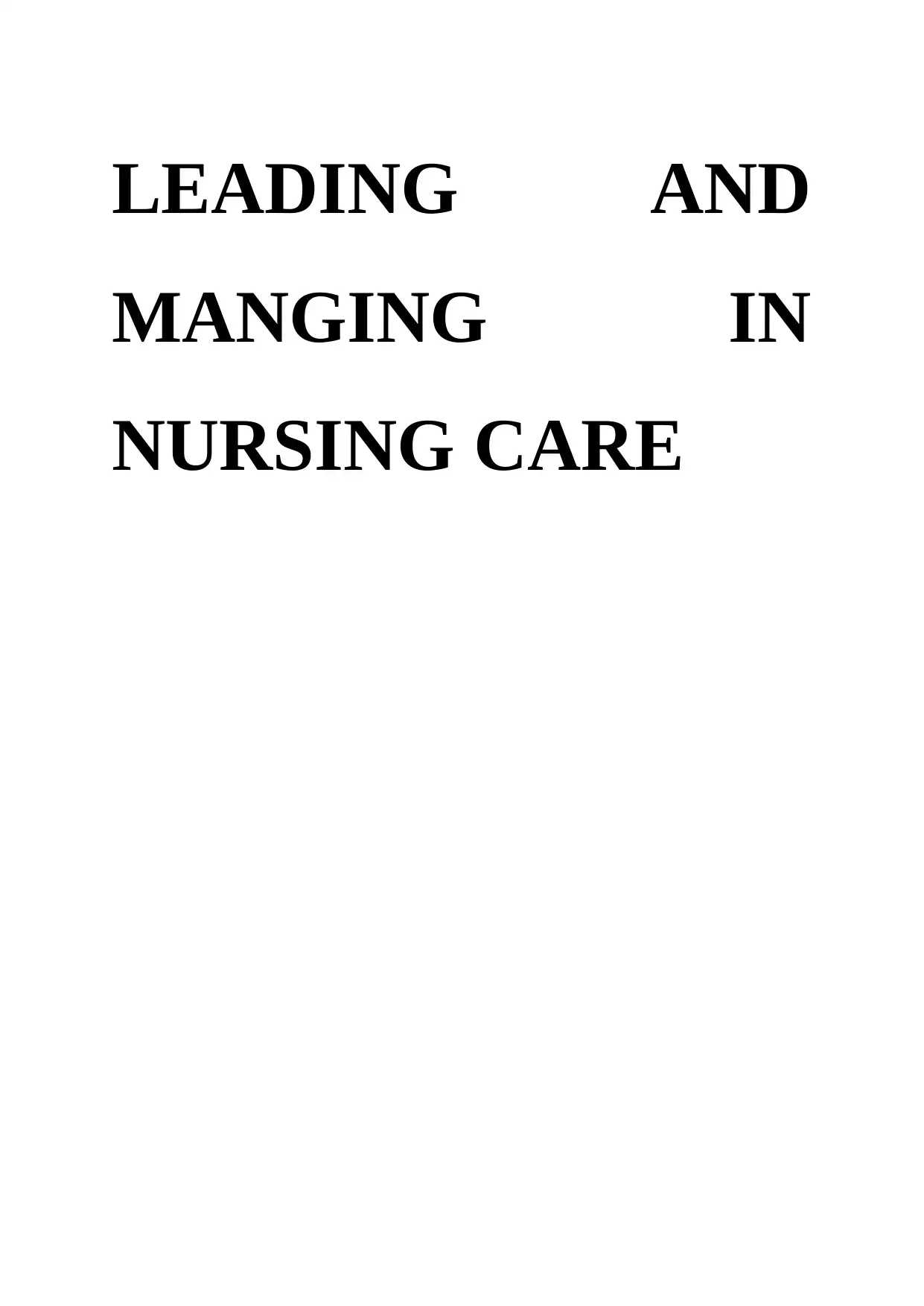
LEADING AND
MANGING IN
NURSING CARE
MANGING IN
NURSING CARE
Paraphrase This Document
Need a fresh take? Get an instant paraphrase of this document with our AI Paraphraser
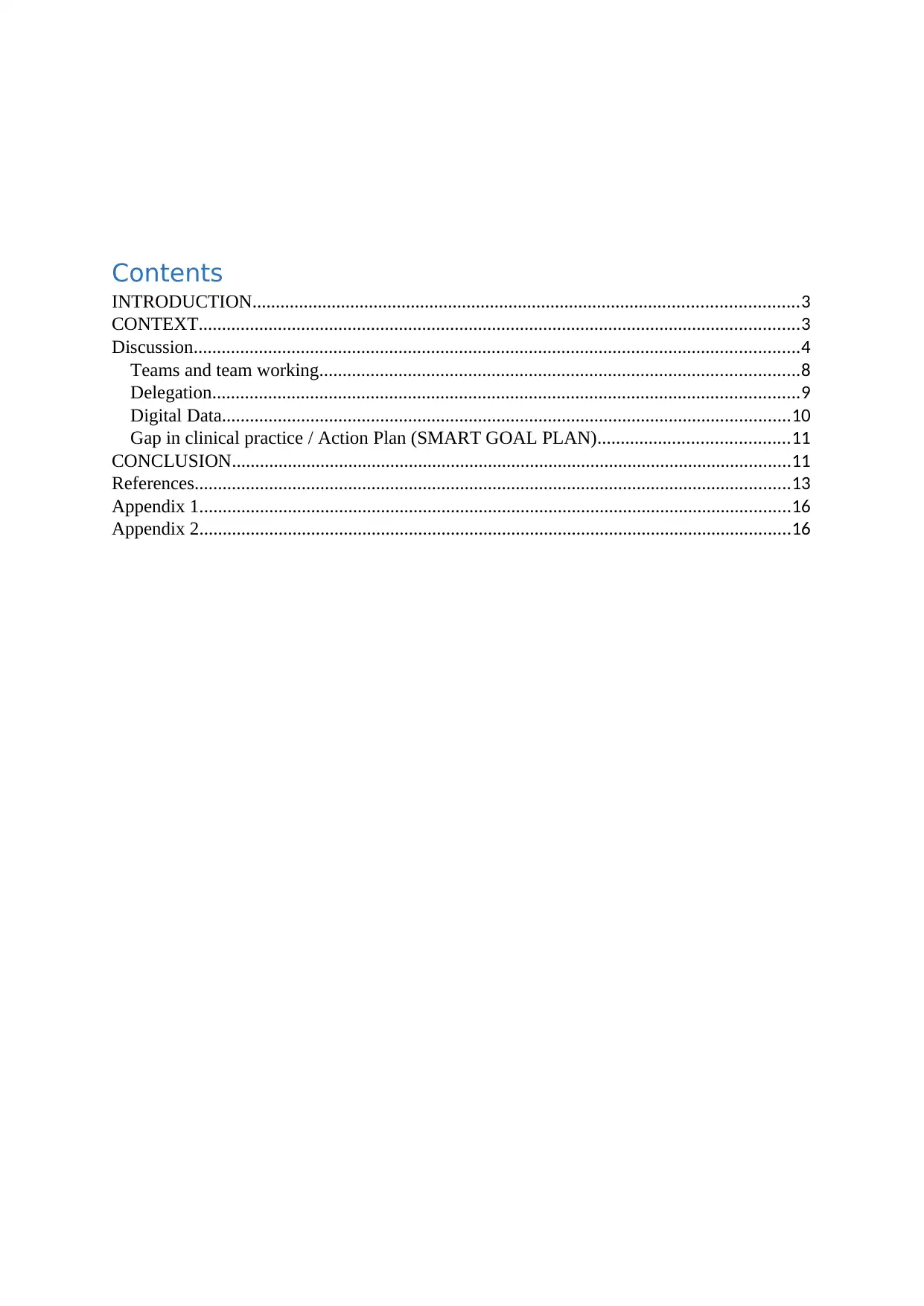
Contents
INTRODUCTION.....................................................................................................................3
CONTEXT.................................................................................................................................3
Discussion..................................................................................................................................4
Teams and team working.......................................................................................................8
Delegation..............................................................................................................................9
Digital Data..........................................................................................................................10
Gap in clinical practice / Action Plan (SMART GOAL PLAN).........................................11
CONCLUSION........................................................................................................................11
References................................................................................................................................13
Appendix 1...............................................................................................................................16
Appendix 2...............................................................................................................................16
INTRODUCTION.....................................................................................................................3
CONTEXT.................................................................................................................................3
Discussion..................................................................................................................................4
Teams and team working.......................................................................................................8
Delegation..............................................................................................................................9
Digital Data..........................................................................................................................10
Gap in clinical practice / Action Plan (SMART GOAL PLAN).........................................11
CONCLUSION........................................................................................................................11
References................................................................................................................................13
Appendix 1...............................................................................................................................16
Appendix 2...............................................................................................................................16
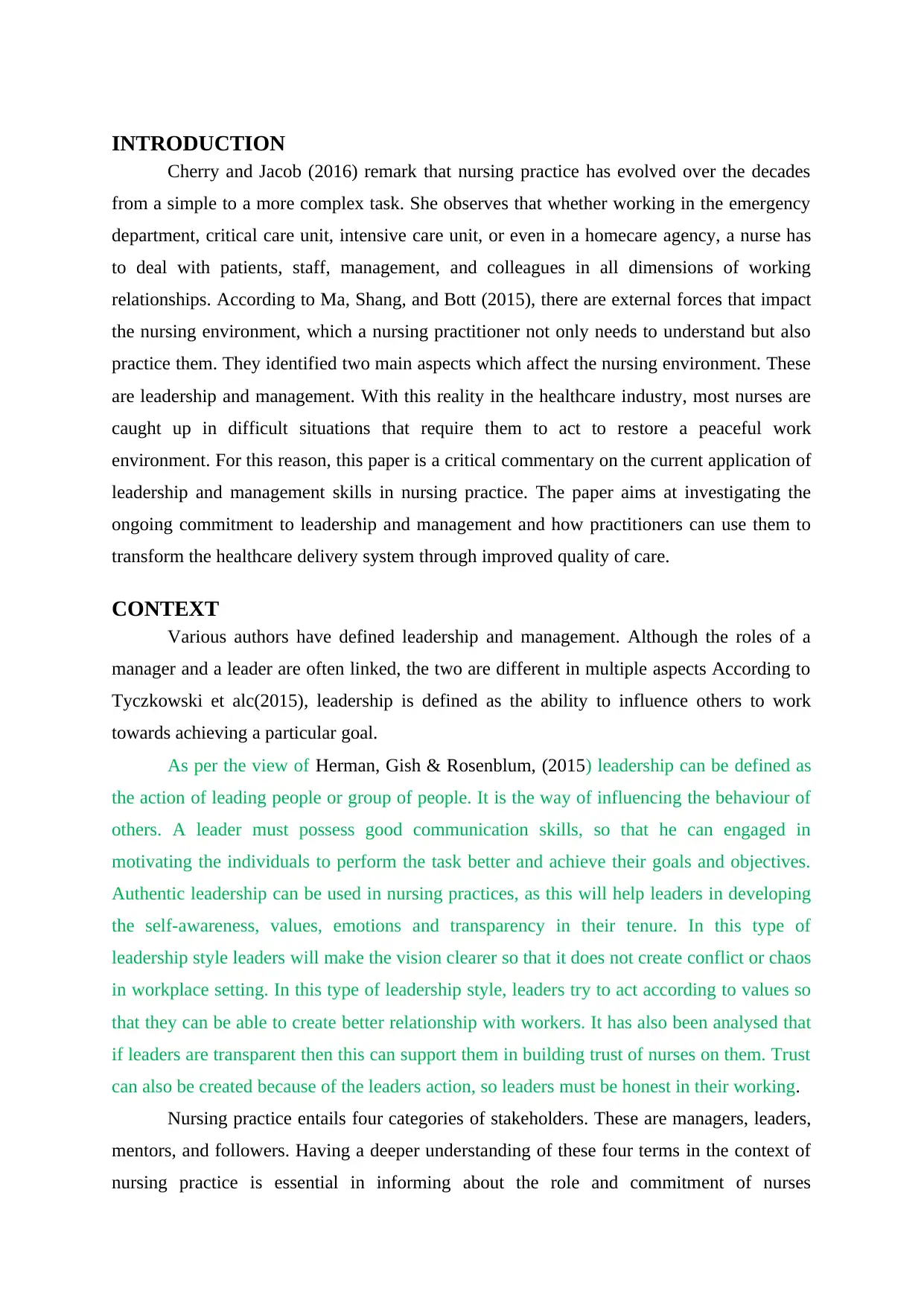
INTRODUCTION
Cherry and Jacob (2016) remark that nursing practice has evolved over the decades
from a simple to a more complex task. She observes that whether working in the emergency
department, critical care unit, intensive care unit, or even in a homecare agency, a nurse has
to deal with patients, staff, management, and colleagues in all dimensions of working
relationships. According to Ma, Shang, and Bott (2015), there are external forces that impact
the nursing environment, which a nursing practitioner not only needs to understand but also
practice them. They identified two main aspects which affect the nursing environment. These
are leadership and management. With this reality in the healthcare industry, most nurses are
caught up in difficult situations that require them to act to restore a peaceful work
environment. For this reason, this paper is a critical commentary on the current application of
leadership and management skills in nursing practice. The paper aims at investigating the
ongoing commitment to leadership and management and how practitioners can use them to
transform the healthcare delivery system through improved quality of care.
CONTEXT
Various authors have defined leadership and management. Although the roles of a
manager and a leader are often linked, the two are different in multiple aspects According to
Tyczkowski et alc(2015), leadership is defined as the ability to influence others to work
towards achieving a particular goal.
As per the view of Herman, Gish & Rosenblum, (2015) leadership can be defined as
the action of leading people or group of people. It is the way of influencing the behaviour of
others. A leader must possess good communication skills, so that he can engaged in
motivating the individuals to perform the task better and achieve their goals and objectives.
Authentic leadership can be used in nursing practices, as this will help leaders in developing
the self-awareness, values, emotions and transparency in their tenure. In this type of
leadership style leaders will make the vision clearer so that it does not create conflict or chaos
in workplace setting. In this type of leadership style, leaders try to act according to values so
that they can be able to create better relationship with workers. It has also been analysed that
if leaders are transparent then this can support them in building trust of nurses on them. Trust
can also be created because of the leaders action, so leaders must be honest in their working.
Nursing practice entails four categories of stakeholders. These are managers, leaders,
mentors, and followers. Having a deeper understanding of these four terms in the context of
nursing practice is essential in informing about the role and commitment of nurses
Cherry and Jacob (2016) remark that nursing practice has evolved over the decades
from a simple to a more complex task. She observes that whether working in the emergency
department, critical care unit, intensive care unit, or even in a homecare agency, a nurse has
to deal with patients, staff, management, and colleagues in all dimensions of working
relationships. According to Ma, Shang, and Bott (2015), there are external forces that impact
the nursing environment, which a nursing practitioner not only needs to understand but also
practice them. They identified two main aspects which affect the nursing environment. These
are leadership and management. With this reality in the healthcare industry, most nurses are
caught up in difficult situations that require them to act to restore a peaceful work
environment. For this reason, this paper is a critical commentary on the current application of
leadership and management skills in nursing practice. The paper aims at investigating the
ongoing commitment to leadership and management and how practitioners can use them to
transform the healthcare delivery system through improved quality of care.
CONTEXT
Various authors have defined leadership and management. Although the roles of a
manager and a leader are often linked, the two are different in multiple aspects According to
Tyczkowski et alc(2015), leadership is defined as the ability to influence others to work
towards achieving a particular goal.
As per the view of Herman, Gish & Rosenblum, (2015) leadership can be defined as
the action of leading people or group of people. It is the way of influencing the behaviour of
others. A leader must possess good communication skills, so that he can engaged in
motivating the individuals to perform the task better and achieve their goals and objectives.
Authentic leadership can be used in nursing practices, as this will help leaders in developing
the self-awareness, values, emotions and transparency in their tenure. In this type of
leadership style leaders will make the vision clearer so that it does not create conflict or chaos
in workplace setting. In this type of leadership style, leaders try to act according to values so
that they can be able to create better relationship with workers. It has also been analysed that
if leaders are transparent then this can support them in building trust of nurses on them. Trust
can also be created because of the leaders action, so leaders must be honest in their working.
Nursing practice entails four categories of stakeholders. These are managers, leaders,
mentors, and followers. Having a deeper understanding of these four terms in the context of
nursing practice is essential in informing about the role and commitment of nurses
⊘ This is a preview!⊘
Do you want full access?
Subscribe today to unlock all pages.

Trusted by 1+ million students worldwide
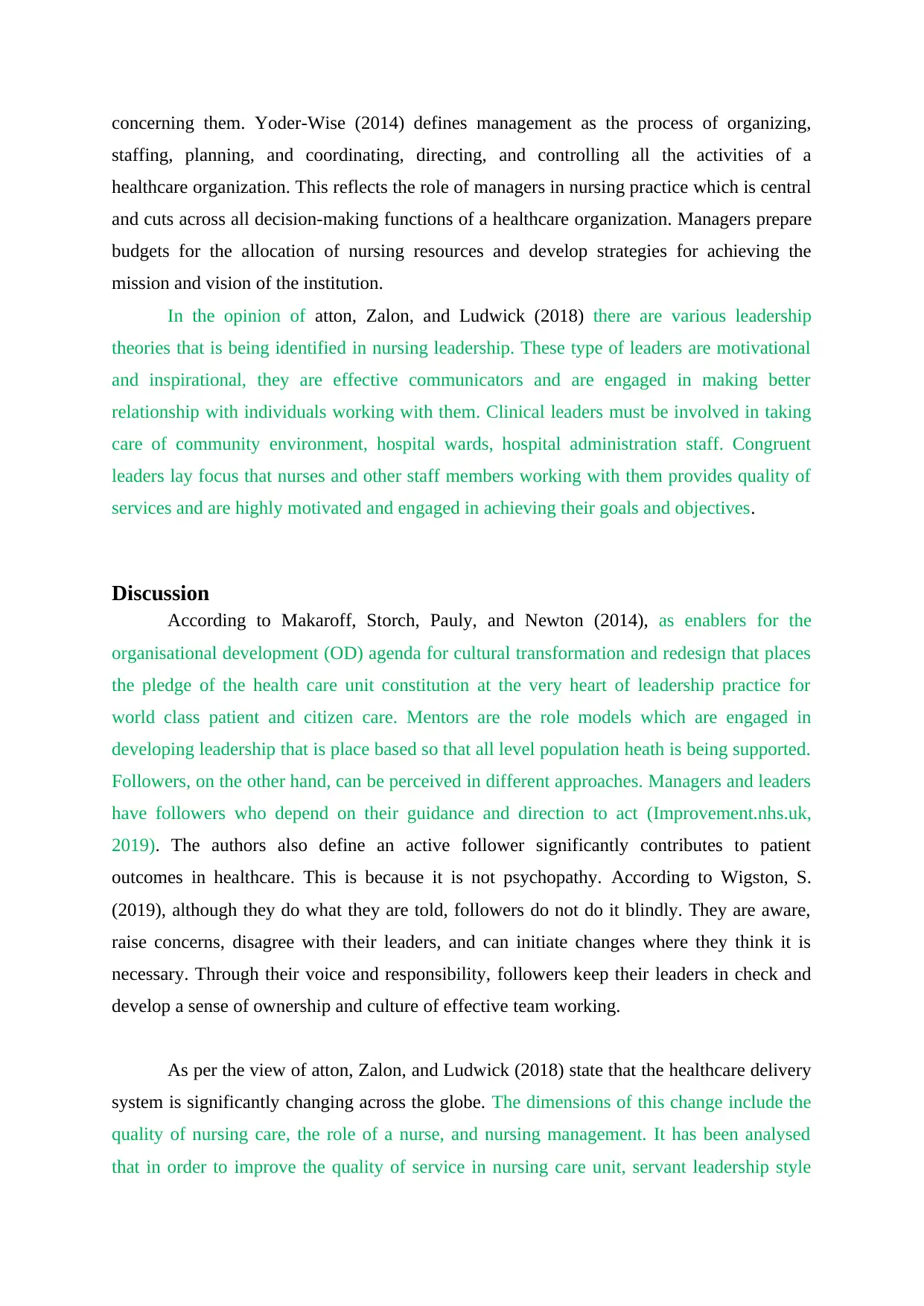
concerning them. Yoder-Wise (2014) defines management as the process of organizing,
staffing, planning, and coordinating, directing, and controlling all the activities of a
healthcare organization. This reflects the role of managers in nursing practice which is central
and cuts across all decision-making functions of a healthcare organization. Managers prepare
budgets for the allocation of nursing resources and develop strategies for achieving the
mission and vision of the institution.
In the opinion of atton, Zalon, and Ludwick (2018) there are various leadership
theories that is being identified in nursing leadership. These type of leaders are motivational
and inspirational, they are effective communicators and are engaged in making better
relationship with individuals working with them. Clinical leaders must be involved in taking
care of community environment, hospital wards, hospital administration staff. Congruent
leaders lay focus that nurses and other staff members working with them provides quality of
services and are highly motivated and engaged in achieving their goals and objectives.
Discussion
According to Makaroff, Storch, Pauly, and Newton (2014), as enablers for the
organisational development (OD) agenda for cultural transformation and redesign that places
the pledge of the health care unit constitution at the very heart of leadership practice for
world class patient and citizen care. Mentors are the role models which are engaged in
developing leadership that is place based so that all level population heath is being supported.
Followers, on the other hand, can be perceived in different approaches. Managers and leaders
have followers who depend on their guidance and direction to act (Improvement.nhs.uk,
2019). The authors also define an active follower significantly contributes to patient
outcomes in healthcare. This is because it is not psychopathy. According to Wigston, S.
(2019), although they do what they are told, followers do not do it blindly. They are aware,
raise concerns, disagree with their leaders, and can initiate changes where they think it is
necessary. Through their voice and responsibility, followers keep their leaders in check and
develop a sense of ownership and culture of effective team working.
As per the view of atton, Zalon, and Ludwick (2018) state that the healthcare delivery
system is significantly changing across the globe. The dimensions of this change include the
quality of nursing care, the role of a nurse, and nursing management. It has been analysed
that in order to improve the quality of service in nursing care unit, servant leadership style
staffing, planning, and coordinating, directing, and controlling all the activities of a
healthcare organization. This reflects the role of managers in nursing practice which is central
and cuts across all decision-making functions of a healthcare organization. Managers prepare
budgets for the allocation of nursing resources and develop strategies for achieving the
mission and vision of the institution.
In the opinion of atton, Zalon, and Ludwick (2018) there are various leadership
theories that is being identified in nursing leadership. These type of leaders are motivational
and inspirational, they are effective communicators and are engaged in making better
relationship with individuals working with them. Clinical leaders must be involved in taking
care of community environment, hospital wards, hospital administration staff. Congruent
leaders lay focus that nurses and other staff members working with them provides quality of
services and are highly motivated and engaged in achieving their goals and objectives.
Discussion
According to Makaroff, Storch, Pauly, and Newton (2014), as enablers for the
organisational development (OD) agenda for cultural transformation and redesign that places
the pledge of the health care unit constitution at the very heart of leadership practice for
world class patient and citizen care. Mentors are the role models which are engaged in
developing leadership that is place based so that all level population heath is being supported.
Followers, on the other hand, can be perceived in different approaches. Managers and leaders
have followers who depend on their guidance and direction to act (Improvement.nhs.uk,
2019). The authors also define an active follower significantly contributes to patient
outcomes in healthcare. This is because it is not psychopathy. According to Wigston, S.
(2019), although they do what they are told, followers do not do it blindly. They are aware,
raise concerns, disagree with their leaders, and can initiate changes where they think it is
necessary. Through their voice and responsibility, followers keep their leaders in check and
develop a sense of ownership and culture of effective team working.
As per the view of atton, Zalon, and Ludwick (2018) state that the healthcare delivery
system is significantly changing across the globe. The dimensions of this change include the
quality of nursing care, the role of a nurse, and nursing management. It has been analysed
that in order to improve the quality of service in nursing care unit, servant leadership style
Paraphrase This Document
Need a fresh take? Get an instant paraphrase of this document with our AI Paraphraser
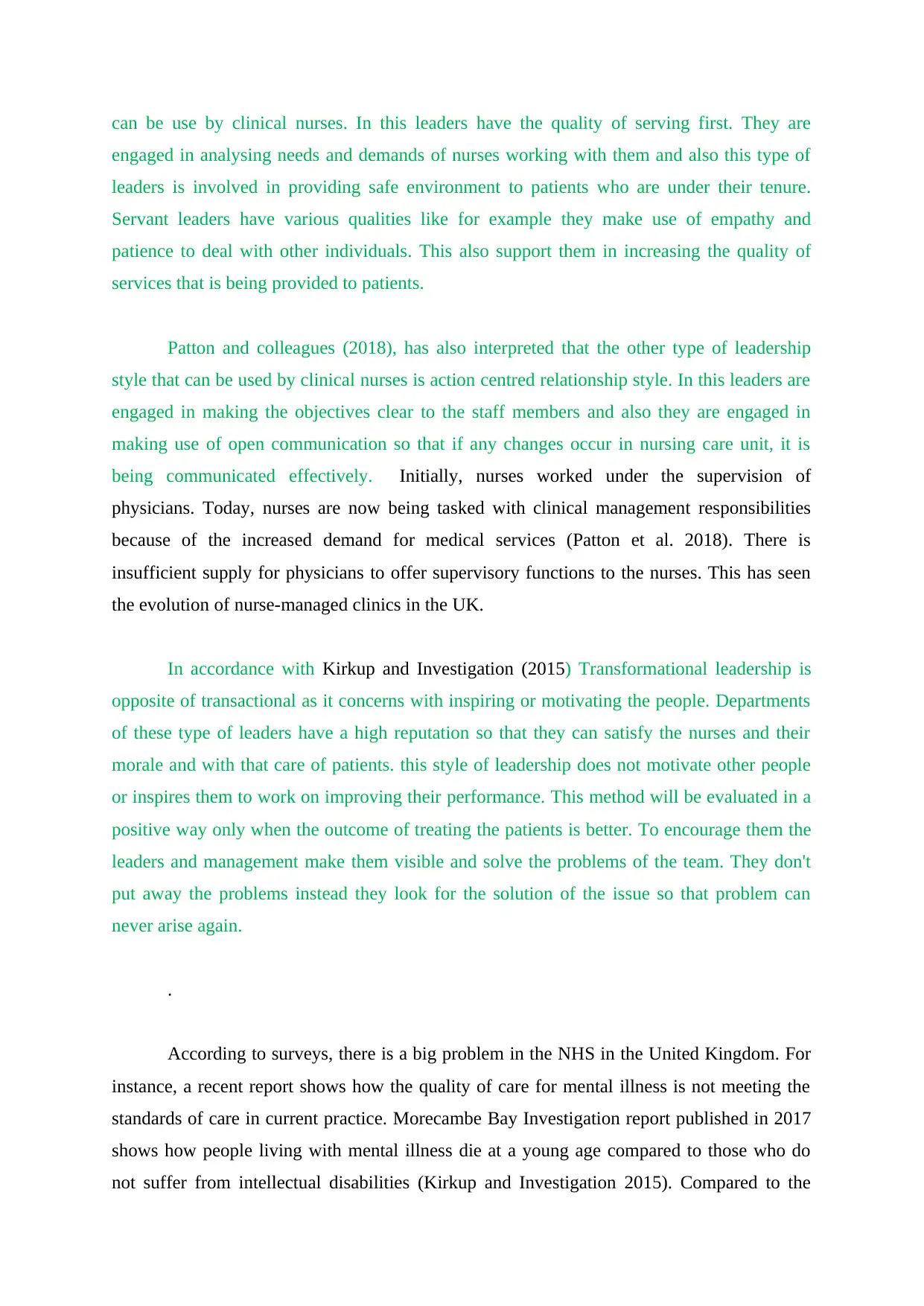
can be use by clinical nurses. In this leaders have the quality of serving first. They are
engaged in analysing needs and demands of nurses working with them and also this type of
leaders is involved in providing safe environment to patients who are under their tenure.
Servant leaders have various qualities like for example they make use of empathy and
patience to deal with other individuals. This also support them in increasing the quality of
services that is being provided to patients.
Patton and colleagues (2018), has also interpreted that the other type of leadership
style that can be used by clinical nurses is action centred relationship style. In this leaders are
engaged in making the objectives clear to the staff members and also they are engaged in
making use of open communication so that if any changes occur in nursing care unit, it is
being communicated effectively. Initially, nurses worked under the supervision of
physicians. Today, nurses are now being tasked with clinical management responsibilities
because of the increased demand for medical services (Patton et al. 2018). There is
insufficient supply for physicians to offer supervisory functions to the nurses. This has seen
the evolution of nurse-managed clinics in the UK.
In accordance with Kirkup and Investigation (2015) Transformational leadership is
opposite of transactional as it concerns with inspiring or motivating the people. Departments
of these type of leaders have a high reputation so that they can satisfy the nurses and their
morale and with that care of patients. this style of leadership does not motivate other people
or inspires them to work on improving their performance. This method will be evaluated in a
positive way only when the outcome of treating the patients is better. To encourage them the
leaders and management make them visible and solve the problems of the team. They don't
put away the problems instead they look for the solution of the issue so that problem can
never arise again.
.
According to surveys, there is a big problem in the NHS in the United Kingdom. For
instance, a recent report shows how the quality of care for mental illness is not meeting the
standards of care in current practice. Morecambe Bay Investigation report published in 2017
shows how people living with mental illness die at a young age compared to those who do
not suffer from intellectual disabilities (Kirkup and Investigation 2015). Compared to the
engaged in analysing needs and demands of nurses working with them and also this type of
leaders is involved in providing safe environment to patients who are under their tenure.
Servant leaders have various qualities like for example they make use of empathy and
patience to deal with other individuals. This also support them in increasing the quality of
services that is being provided to patients.
Patton and colleagues (2018), has also interpreted that the other type of leadership
style that can be used by clinical nurses is action centred relationship style. In this leaders are
engaged in making the objectives clear to the staff members and also they are engaged in
making use of open communication so that if any changes occur in nursing care unit, it is
being communicated effectively. Initially, nurses worked under the supervision of
physicians. Today, nurses are now being tasked with clinical management responsibilities
because of the increased demand for medical services (Patton et al. 2018). There is
insufficient supply for physicians to offer supervisory functions to the nurses. This has seen
the evolution of nurse-managed clinics in the UK.
In accordance with Kirkup and Investigation (2015) Transformational leadership is
opposite of transactional as it concerns with inspiring or motivating the people. Departments
of these type of leaders have a high reputation so that they can satisfy the nurses and their
morale and with that care of patients. this style of leadership does not motivate other people
or inspires them to work on improving their performance. This method will be evaluated in a
positive way only when the outcome of treating the patients is better. To encourage them the
leaders and management make them visible and solve the problems of the team. They don't
put away the problems instead they look for the solution of the issue so that problem can
never arise again.
.
According to surveys, there is a big problem in the NHS in the United Kingdom. For
instance, a recent report shows how the quality of care for mental illness is not meeting the
standards of care in current practice. Morecambe Bay Investigation report published in 2017
shows how people living with mental illness die at a young age compared to those who do
not suffer from intellectual disabilities (Kirkup and Investigation 2015). Compared to the
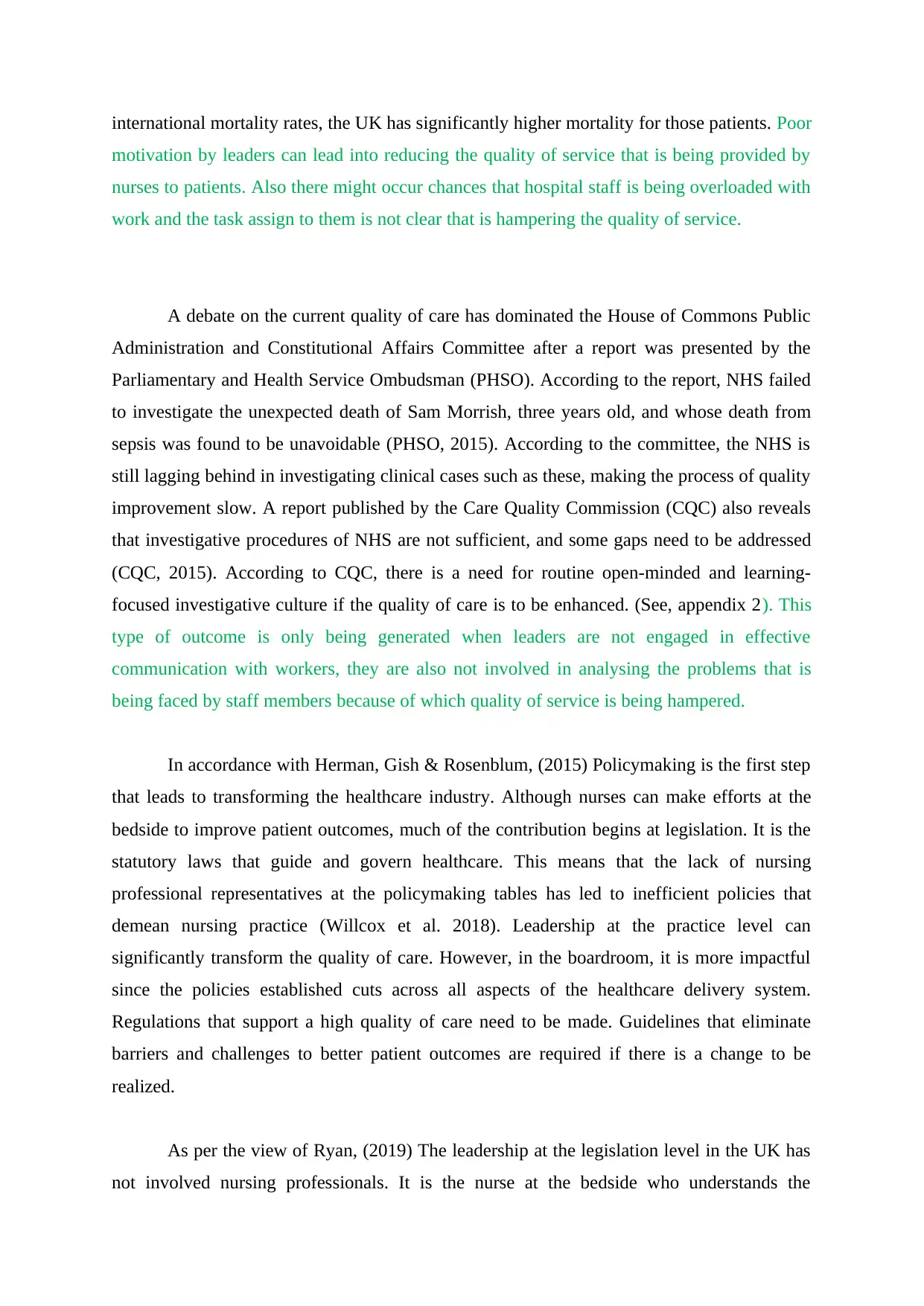
international mortality rates, the UK has significantly higher mortality for those patients. Poor
motivation by leaders can lead into reducing the quality of service that is being provided by
nurses to patients. Also there might occur chances that hospital staff is being overloaded with
work and the task assign to them is not clear that is hampering the quality of service.
A debate on the current quality of care has dominated the House of Commons Public
Administration and Constitutional Affairs Committee after a report was presented by the
Parliamentary and Health Service Ombudsman (PHSO). According to the report, NHS failed
to investigate the unexpected death of Sam Morrish, three years old, and whose death from
sepsis was found to be unavoidable (PHSO, 2015). According to the committee, the NHS is
still lagging behind in investigating clinical cases such as these, making the process of quality
improvement slow. A report published by the Care Quality Commission (CQC) also reveals
that investigative procedures of NHS are not sufficient, and some gaps need to be addressed
(CQC, 2015). According to CQC, there is a need for routine open-minded and learning-
focused investigative culture if the quality of care is to be enhanced. (See, appendix 2). This
type of outcome is only being generated when leaders are not engaged in effective
communication with workers, they are also not involved in analysing the problems that is
being faced by staff members because of which quality of service is being hampered.
In accordance with Herman, Gish & Rosenblum, (2015) Policymaking is the first step
that leads to transforming the healthcare industry. Although nurses can make efforts at the
bedside to improve patient outcomes, much of the contribution begins at legislation. It is the
statutory laws that guide and govern healthcare. This means that the lack of nursing
professional representatives at the policymaking tables has led to inefficient policies that
demean nursing practice (Willcox et al. 2018). Leadership at the practice level can
significantly transform the quality of care. However, in the boardroom, it is more impactful
since the policies established cuts across all aspects of the healthcare delivery system.
Regulations that support a high quality of care need to be made. Guidelines that eliminate
barriers and challenges to better patient outcomes are required if there is a change to be
realized.
As per the view of Ryan, (2019) The leadership at the legislation level in the UK has
not involved nursing professionals. It is the nurse at the bedside who understands the
motivation by leaders can lead into reducing the quality of service that is being provided by
nurses to patients. Also there might occur chances that hospital staff is being overloaded with
work and the task assign to them is not clear that is hampering the quality of service.
A debate on the current quality of care has dominated the House of Commons Public
Administration and Constitutional Affairs Committee after a report was presented by the
Parliamentary and Health Service Ombudsman (PHSO). According to the report, NHS failed
to investigate the unexpected death of Sam Morrish, three years old, and whose death from
sepsis was found to be unavoidable (PHSO, 2015). According to the committee, the NHS is
still lagging behind in investigating clinical cases such as these, making the process of quality
improvement slow. A report published by the Care Quality Commission (CQC) also reveals
that investigative procedures of NHS are not sufficient, and some gaps need to be addressed
(CQC, 2015). According to CQC, there is a need for routine open-minded and learning-
focused investigative culture if the quality of care is to be enhanced. (See, appendix 2). This
type of outcome is only being generated when leaders are not engaged in effective
communication with workers, they are also not involved in analysing the problems that is
being faced by staff members because of which quality of service is being hampered.
In accordance with Herman, Gish & Rosenblum, (2015) Policymaking is the first step
that leads to transforming the healthcare industry. Although nurses can make efforts at the
bedside to improve patient outcomes, much of the contribution begins at legislation. It is the
statutory laws that guide and govern healthcare. This means that the lack of nursing
professional representatives at the policymaking tables has led to inefficient policies that
demean nursing practice (Willcox et al. 2018). Leadership at the practice level can
significantly transform the quality of care. However, in the boardroom, it is more impactful
since the policies established cuts across all aspects of the healthcare delivery system.
Regulations that support a high quality of care need to be made. Guidelines that eliminate
barriers and challenges to better patient outcomes are required if there is a change to be
realized.
As per the view of Ryan, (2019) The leadership at the legislation level in the UK has
not involved nursing professionals. It is the nurse at the bedside who understands the
⊘ This is a preview!⊘
Do you want full access?
Subscribe today to unlock all pages.

Trusted by 1+ million students worldwide
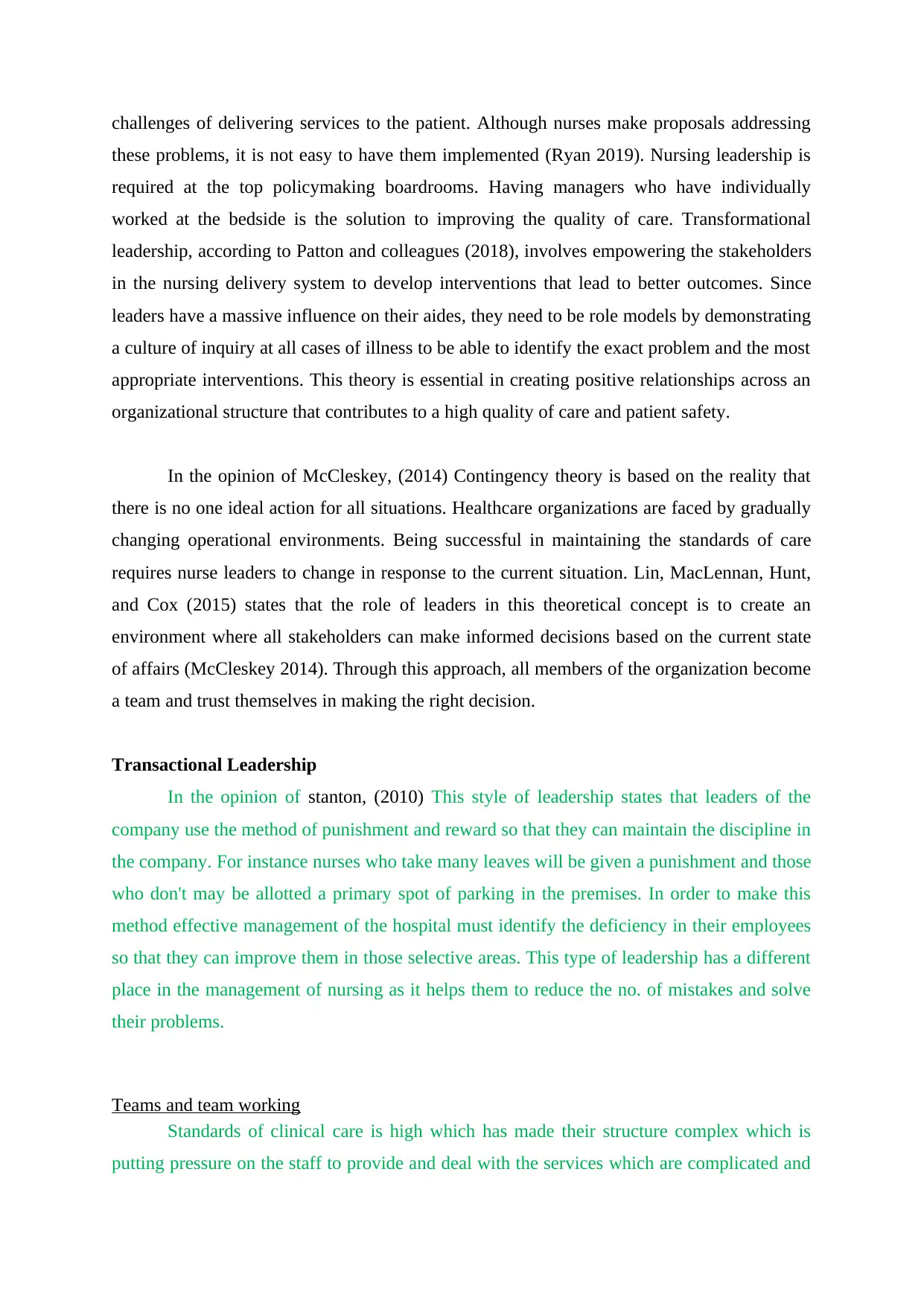
challenges of delivering services to the patient. Although nurses make proposals addressing
these problems, it is not easy to have them implemented (Ryan 2019). Nursing leadership is
required at the top policymaking boardrooms. Having managers who have individually
worked at the bedside is the solution to improving the quality of care. Transformational
leadership, according to Patton and colleagues (2018), involves empowering the stakeholders
in the nursing delivery system to develop interventions that lead to better outcomes. Since
leaders have a massive influence on their aides, they need to be role models by demonstrating
a culture of inquiry at all cases of illness to be able to identify the exact problem and the most
appropriate interventions. This theory is essential in creating positive relationships across an
organizational structure that contributes to a high quality of care and patient safety.
In the opinion of McCleskey, (2014) Contingency theory is based on the reality that
there is no one ideal action for all situations. Healthcare organizations are faced by gradually
changing operational environments. Being successful in maintaining the standards of care
requires nurse leaders to change in response to the current situation. Lin, MacLennan, Hunt,
and Cox (2015) states that the role of leaders in this theoretical concept is to create an
environment where all stakeholders can make informed decisions based on the current state
of affairs (McCleskey 2014). Through this approach, all members of the organization become
a team and trust themselves in making the right decision.
Transactional Leadership
In the opinion of stanton, (2010) This style of leadership states that leaders of the
company use the method of punishment and reward so that they can maintain the discipline in
the company. For instance nurses who take many leaves will be given a punishment and those
who don't may be allotted a primary spot of parking in the premises. In order to make this
method effective management of the hospital must identify the deficiency in their employees
so that they can improve them in those selective areas. This type of leadership has a different
place in the management of nursing as it helps them to reduce the no. of mistakes and solve
their problems.
Teams and team working
Standards of clinical care is high which has made their structure complex which is
putting pressure on the staff to provide and deal with the services which are complicated and
these problems, it is not easy to have them implemented (Ryan 2019). Nursing leadership is
required at the top policymaking boardrooms. Having managers who have individually
worked at the bedside is the solution to improving the quality of care. Transformational
leadership, according to Patton and colleagues (2018), involves empowering the stakeholders
in the nursing delivery system to develop interventions that lead to better outcomes. Since
leaders have a massive influence on their aides, they need to be role models by demonstrating
a culture of inquiry at all cases of illness to be able to identify the exact problem and the most
appropriate interventions. This theory is essential in creating positive relationships across an
organizational structure that contributes to a high quality of care and patient safety.
In the opinion of McCleskey, (2014) Contingency theory is based on the reality that
there is no one ideal action for all situations. Healthcare organizations are faced by gradually
changing operational environments. Being successful in maintaining the standards of care
requires nurse leaders to change in response to the current situation. Lin, MacLennan, Hunt,
and Cox (2015) states that the role of leaders in this theoretical concept is to create an
environment where all stakeholders can make informed decisions based on the current state
of affairs (McCleskey 2014). Through this approach, all members of the organization become
a team and trust themselves in making the right decision.
Transactional Leadership
In the opinion of stanton, (2010) This style of leadership states that leaders of the
company use the method of punishment and reward so that they can maintain the discipline in
the company. For instance nurses who take many leaves will be given a punishment and those
who don't may be allotted a primary spot of parking in the premises. In order to make this
method effective management of the hospital must identify the deficiency in their employees
so that they can improve them in those selective areas. This type of leadership has a different
place in the management of nursing as it helps them to reduce the no. of mistakes and solve
their problems.
Teams and team working
Standards of clinical care is high which has made their structure complex which is
putting pressure on the staff to provide and deal with the services which are complicated and
Paraphrase This Document
Need a fresh take? Get an instant paraphrase of this document with our AI Paraphraser
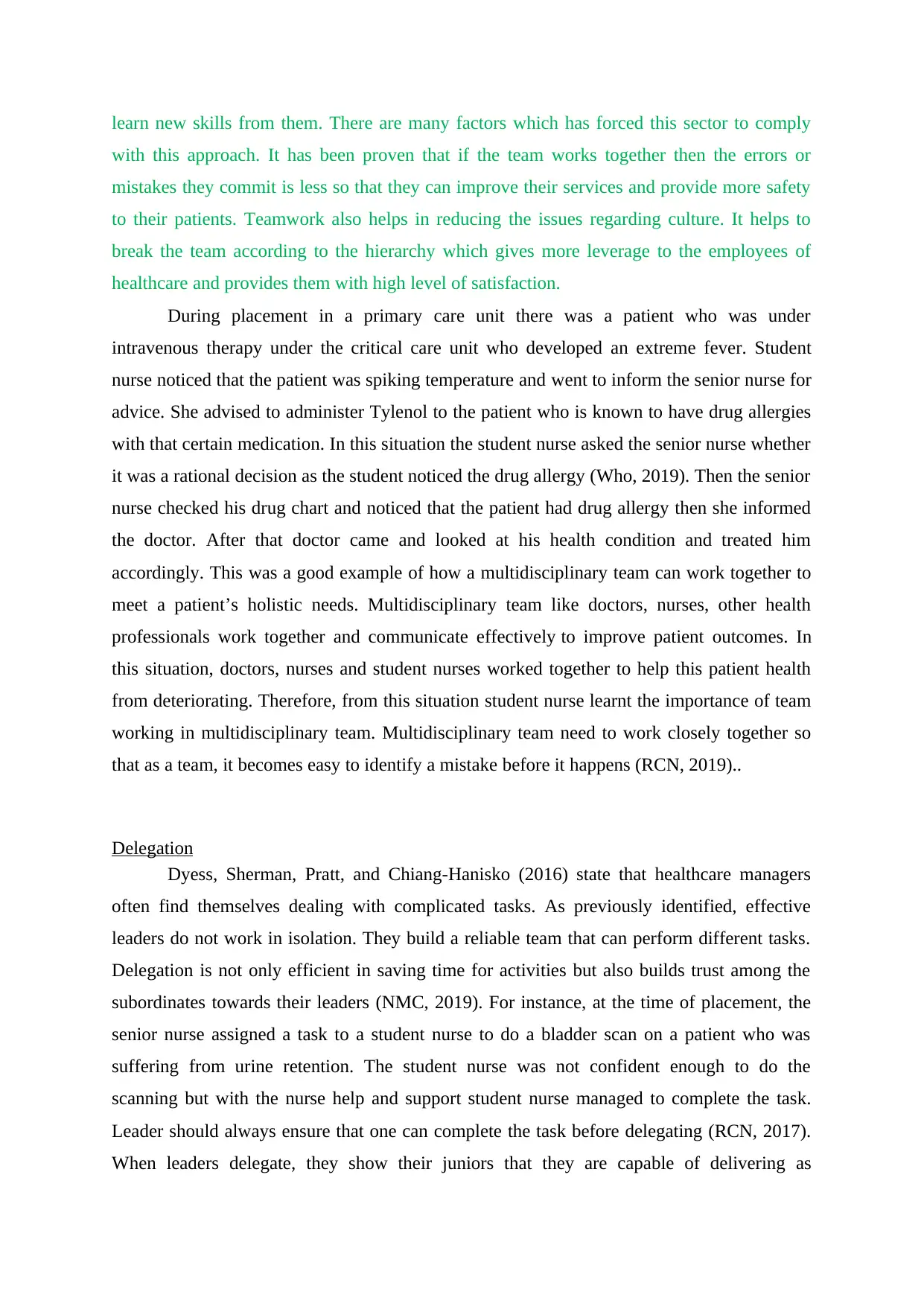
learn new skills from them. There are many factors which has forced this sector to comply
with this approach. It has been proven that if the team works together then the errors or
mistakes they commit is less so that they can improve their services and provide more safety
to their patients. Teamwork also helps in reducing the issues regarding culture. It helps to
break the team according to the hierarchy which gives more leverage to the employees of
healthcare and provides them with high level of satisfaction.
During placement in a primary care unit there was a patient who was under
intravenous therapy under the critical care unit who developed an extreme fever. Student
nurse noticed that the patient was spiking temperature and went to inform the senior nurse for
advice. She advised to administer Tylenol to the patient who is known to have drug allergies
with that certain medication. In this situation the student nurse asked the senior nurse whether
it was a rational decision as the student noticed the drug allergy (Who, 2019). Then the senior
nurse checked his drug chart and noticed that the patient had drug allergy then she informed
the doctor. After that doctor came and looked at his health condition and treated him
accordingly. This was a good example of how a multidisciplinary team can work together to
meet a patient’s holistic needs. Multidisciplinary team like doctors, nurses, other health
professionals work together and communicate effectively to improve patient outcomes. In
this situation, doctors, nurses and student nurses worked together to help this patient health
from deteriorating. Therefore, from this situation student nurse learnt the importance of team
working in multidisciplinary team. Multidisciplinary team need to work closely together so
that as a team, it becomes easy to identify a mistake before it happens (RCN, 2019)..
Delegation
Dyess, Sherman, Pratt, and Chiang-Hanisko (2016) state that healthcare managers
often find themselves dealing with complicated tasks. As previously identified, effective
leaders do not work in isolation. They build a reliable team that can perform different tasks.
Delegation is not only efficient in saving time for activities but also builds trust among the
subordinates towards their leaders (NMC, 2019). For instance, at the time of placement, the
senior nurse assigned a task to a student nurse to do a bladder scan on a patient who was
suffering from urine retention. The student nurse was not confident enough to do the
scanning but with the nurse help and support student nurse managed to complete the task.
Leader should always ensure that one can complete the task before delegating (RCN, 2017).
When leaders delegate, they show their juniors that they are capable of delivering as
with this approach. It has been proven that if the team works together then the errors or
mistakes they commit is less so that they can improve their services and provide more safety
to their patients. Teamwork also helps in reducing the issues regarding culture. It helps to
break the team according to the hierarchy which gives more leverage to the employees of
healthcare and provides them with high level of satisfaction.
During placement in a primary care unit there was a patient who was under
intravenous therapy under the critical care unit who developed an extreme fever. Student
nurse noticed that the patient was spiking temperature and went to inform the senior nurse for
advice. She advised to administer Tylenol to the patient who is known to have drug allergies
with that certain medication. In this situation the student nurse asked the senior nurse whether
it was a rational decision as the student noticed the drug allergy (Who, 2019). Then the senior
nurse checked his drug chart and noticed that the patient had drug allergy then she informed
the doctor. After that doctor came and looked at his health condition and treated him
accordingly. This was a good example of how a multidisciplinary team can work together to
meet a patient’s holistic needs. Multidisciplinary team like doctors, nurses, other health
professionals work together and communicate effectively to improve patient outcomes. In
this situation, doctors, nurses and student nurses worked together to help this patient health
from deteriorating. Therefore, from this situation student nurse learnt the importance of team
working in multidisciplinary team. Multidisciplinary team need to work closely together so
that as a team, it becomes easy to identify a mistake before it happens (RCN, 2019)..
Delegation
Dyess, Sherman, Pratt, and Chiang-Hanisko (2016) state that healthcare managers
often find themselves dealing with complicated tasks. As previously identified, effective
leaders do not work in isolation. They build a reliable team that can perform different tasks.
Delegation is not only efficient in saving time for activities but also builds trust among the
subordinates towards their leaders (NMC, 2019). For instance, at the time of placement, the
senior nurse assigned a task to a student nurse to do a bladder scan on a patient who was
suffering from urine retention. The student nurse was not confident enough to do the
scanning but with the nurse help and support student nurse managed to complete the task.
Leader should always ensure that one can complete the task before delegating (RCN, 2017).
When leaders delegate, they show their juniors that they are capable of delivering as
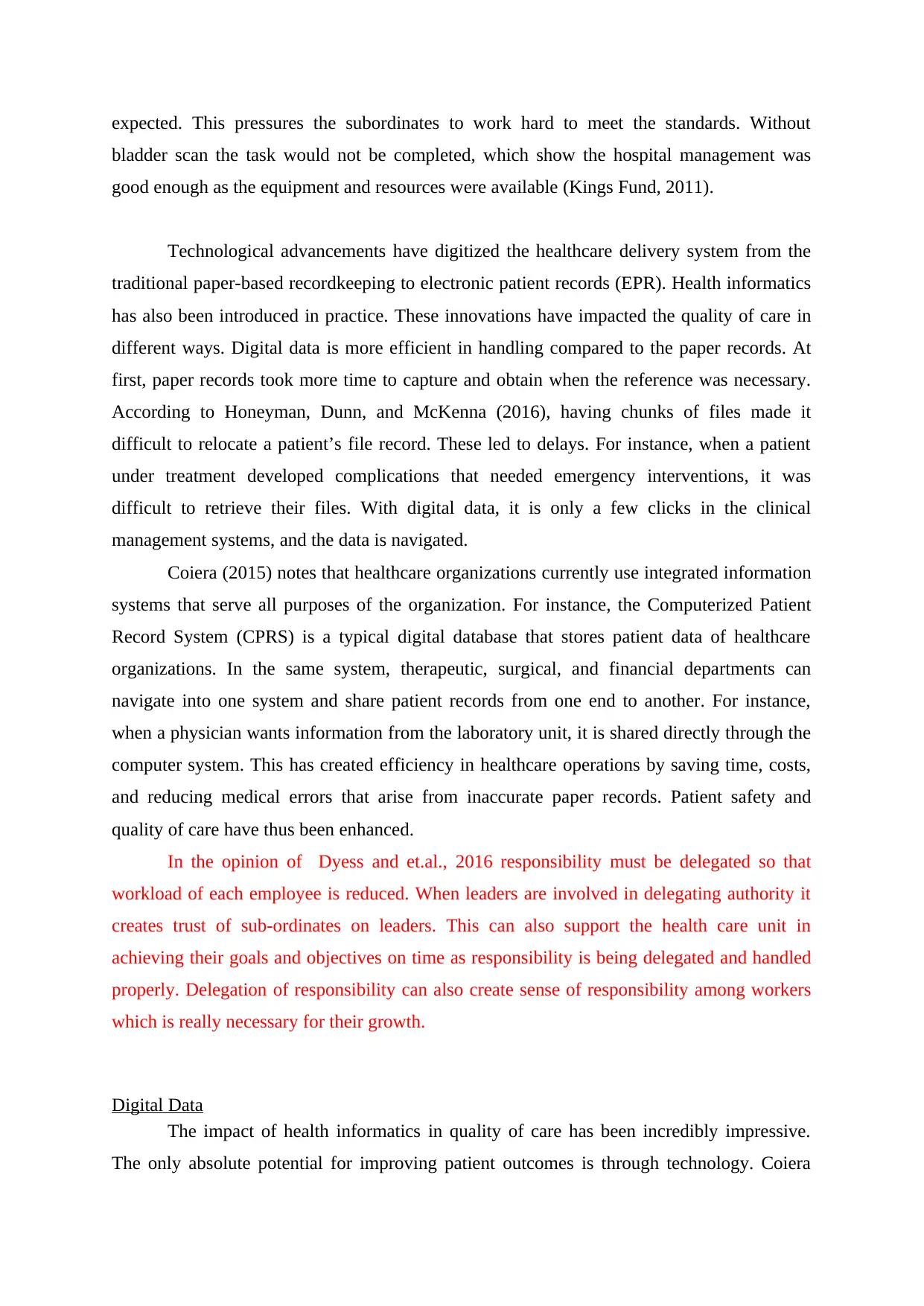
expected. This pressures the subordinates to work hard to meet the standards. Without
bladder scan the task would not be completed, which show the hospital management was
good enough as the equipment and resources were available (Kings Fund, 2011).
Technological advancements have digitized the healthcare delivery system from the
traditional paper-based recordkeeping to electronic patient records (EPR). Health informatics
has also been introduced in practice. These innovations have impacted the quality of care in
different ways. Digital data is more efficient in handling compared to the paper records. At
first, paper records took more time to capture and obtain when the reference was necessary.
According to Honeyman, Dunn, and McKenna (2016), having chunks of files made it
difficult to relocate a patient’s file record. These led to delays. For instance, when a patient
under treatment developed complications that needed emergency interventions, it was
difficult to retrieve their files. With digital data, it is only a few clicks in the clinical
management systems, and the data is navigated.
Coiera (2015) notes that healthcare organizations currently use integrated information
systems that serve all purposes of the organization. For instance, the Computerized Patient
Record System (CPRS) is a typical digital database that stores patient data of healthcare
organizations. In the same system, therapeutic, surgical, and financial departments can
navigate into one system and share patient records from one end to another. For instance,
when a physician wants information from the laboratory unit, it is shared directly through the
computer system. This has created efficiency in healthcare operations by saving time, costs,
and reducing medical errors that arise from inaccurate paper records. Patient safety and
quality of care have thus been enhanced.
In the opinion of Dyess and et.al., 2016 responsibility must be delegated so that
workload of each employee is reduced. When leaders are involved in delegating authority it
creates trust of sub-ordinates on leaders. This can also support the health care unit in
achieving their goals and objectives on time as responsibility is being delegated and handled
properly. Delegation of responsibility can also create sense of responsibility among workers
which is really necessary for their growth.
Digital Data
The impact of health informatics in quality of care has been incredibly impressive.
The only absolute potential for improving patient outcomes is through technology. Coiera
bladder scan the task would not be completed, which show the hospital management was
good enough as the equipment and resources were available (Kings Fund, 2011).
Technological advancements have digitized the healthcare delivery system from the
traditional paper-based recordkeeping to electronic patient records (EPR). Health informatics
has also been introduced in practice. These innovations have impacted the quality of care in
different ways. Digital data is more efficient in handling compared to the paper records. At
first, paper records took more time to capture and obtain when the reference was necessary.
According to Honeyman, Dunn, and McKenna (2016), having chunks of files made it
difficult to relocate a patient’s file record. These led to delays. For instance, when a patient
under treatment developed complications that needed emergency interventions, it was
difficult to retrieve their files. With digital data, it is only a few clicks in the clinical
management systems, and the data is navigated.
Coiera (2015) notes that healthcare organizations currently use integrated information
systems that serve all purposes of the organization. For instance, the Computerized Patient
Record System (CPRS) is a typical digital database that stores patient data of healthcare
organizations. In the same system, therapeutic, surgical, and financial departments can
navigate into one system and share patient records from one end to another. For instance,
when a physician wants information from the laboratory unit, it is shared directly through the
computer system. This has created efficiency in healthcare operations by saving time, costs,
and reducing medical errors that arise from inaccurate paper records. Patient safety and
quality of care have thus been enhanced.
In the opinion of Dyess and et.al., 2016 responsibility must be delegated so that
workload of each employee is reduced. When leaders are involved in delegating authority it
creates trust of sub-ordinates on leaders. This can also support the health care unit in
achieving their goals and objectives on time as responsibility is being delegated and handled
properly. Delegation of responsibility can also create sense of responsibility among workers
which is really necessary for their growth.
Digital Data
The impact of health informatics in quality of care has been incredibly impressive.
The only absolute potential for improving patient outcomes is through technology. Coiera
⊘ This is a preview!⊘
Do you want full access?
Subscribe today to unlock all pages.

Trusted by 1+ million students worldwide
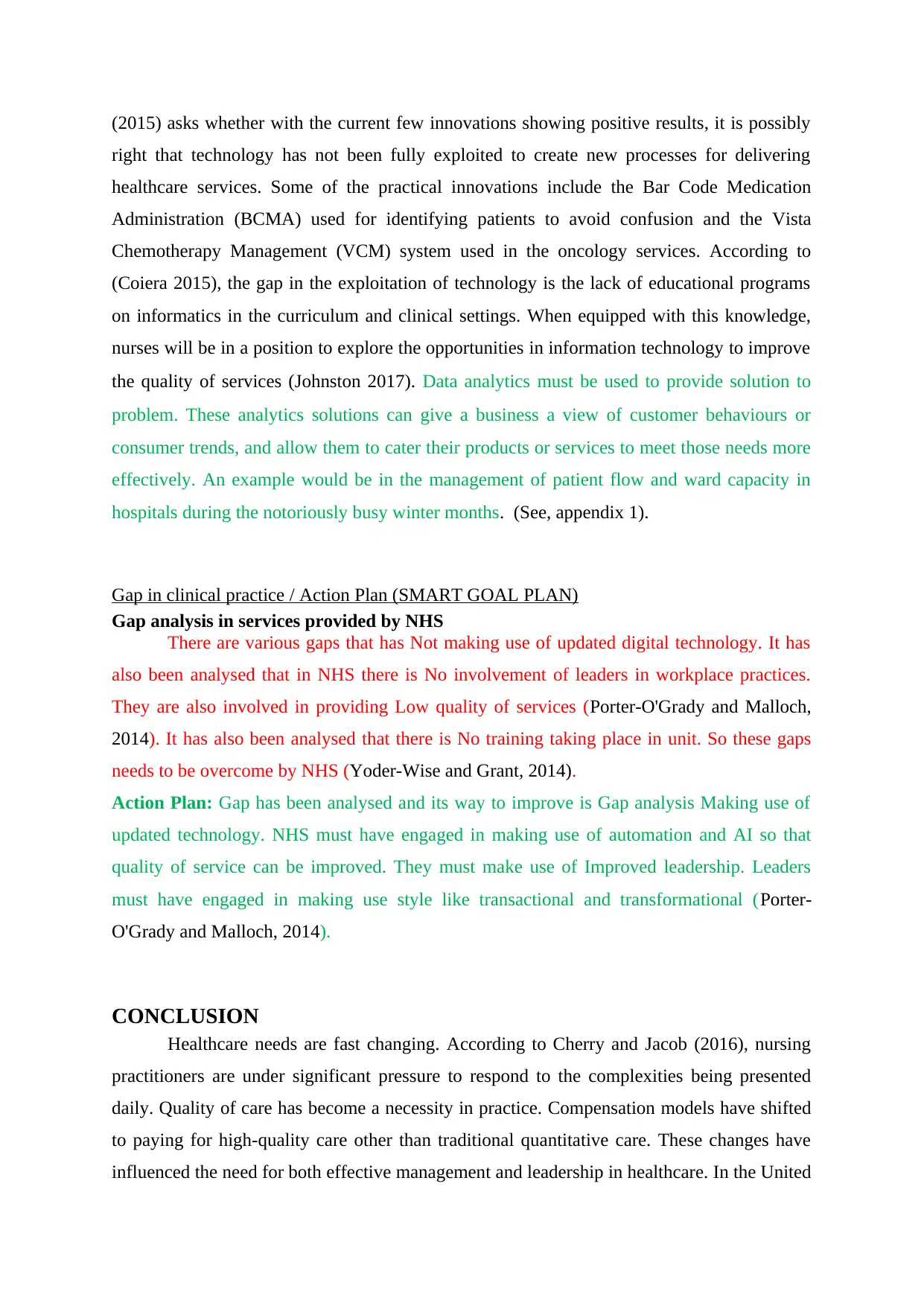
(2015) asks whether with the current few innovations showing positive results, it is possibly
right that technology has not been fully exploited to create new processes for delivering
healthcare services. Some of the practical innovations include the Bar Code Medication
Administration (BCMA) used for identifying patients to avoid confusion and the Vista
Chemotherapy Management (VCM) system used in the oncology services. According to
(Coiera 2015), the gap in the exploitation of technology is the lack of educational programs
on informatics in the curriculum and clinical settings. When equipped with this knowledge,
nurses will be in a position to explore the opportunities in information technology to improve
the quality of services (Johnston 2017). Data analytics must be used to provide solution to
problem. These analytics solutions can give a business a view of customer behaviours or
consumer trends, and allow them to cater their products or services to meet those needs more
effectively. An example would be in the management of patient flow and ward capacity in
hospitals during the notoriously busy winter months. (See, appendix 1).
Gap in clinical practice / Action Plan (SMART GOAL PLAN)
Gap analysis in services provided by NHS
There are various gaps that has Not making use of updated digital technology. It has
also been analysed that in NHS there is No involvement of leaders in workplace practices.
They are also involved in providing Low quality of services (Porter-O'Grady and Malloch,
2014). It has also been analysed that there is No training taking place in unit. So these gaps
needs to be overcome by NHS (Yoder-Wise and Grant, 2014).
Action Plan: Gap has been analysed and its way to improve is Gap analysis Making use of
updated technology. NHS must have engaged in making use of automation and AI so that
quality of service can be improved. They must make use of Improved leadership. Leaders
must have engaged in making use style like transactional and transformational (Porter-
O'Grady and Malloch, 2014).
CONCLUSION
Healthcare needs are fast changing. According to Cherry and Jacob (2016), nursing
practitioners are under significant pressure to respond to the complexities being presented
daily. Quality of care has become a necessity in practice. Compensation models have shifted
to paying for high-quality care other than traditional quantitative care. These changes have
influenced the need for both effective management and leadership in healthcare. In the United
right that technology has not been fully exploited to create new processes for delivering
healthcare services. Some of the practical innovations include the Bar Code Medication
Administration (BCMA) used for identifying patients to avoid confusion and the Vista
Chemotherapy Management (VCM) system used in the oncology services. According to
(Coiera 2015), the gap in the exploitation of technology is the lack of educational programs
on informatics in the curriculum and clinical settings. When equipped with this knowledge,
nurses will be in a position to explore the opportunities in information technology to improve
the quality of services (Johnston 2017). Data analytics must be used to provide solution to
problem. These analytics solutions can give a business a view of customer behaviours or
consumer trends, and allow them to cater their products or services to meet those needs more
effectively. An example would be in the management of patient flow and ward capacity in
hospitals during the notoriously busy winter months. (See, appendix 1).
Gap in clinical practice / Action Plan (SMART GOAL PLAN)
Gap analysis in services provided by NHS
There are various gaps that has Not making use of updated digital technology. It has
also been analysed that in NHS there is No involvement of leaders in workplace practices.
They are also involved in providing Low quality of services (Porter-O'Grady and Malloch,
2014). It has also been analysed that there is No training taking place in unit. So these gaps
needs to be overcome by NHS (Yoder-Wise and Grant, 2014).
Action Plan: Gap has been analysed and its way to improve is Gap analysis Making use of
updated technology. NHS must have engaged in making use of automation and AI so that
quality of service can be improved. They must make use of Improved leadership. Leaders
must have engaged in making use style like transactional and transformational (Porter-
O'Grady and Malloch, 2014).
CONCLUSION
Healthcare needs are fast changing. According to Cherry and Jacob (2016), nursing
practitioners are under significant pressure to respond to the complexities being presented
daily. Quality of care has become a necessity in practice. Compensation models have shifted
to paying for high-quality care other than traditional quantitative care. These changes have
influenced the need for both effective management and leadership in healthcare. In the United
Paraphrase This Document
Need a fresh take? Get an instant paraphrase of this document with our AI Paraphraser
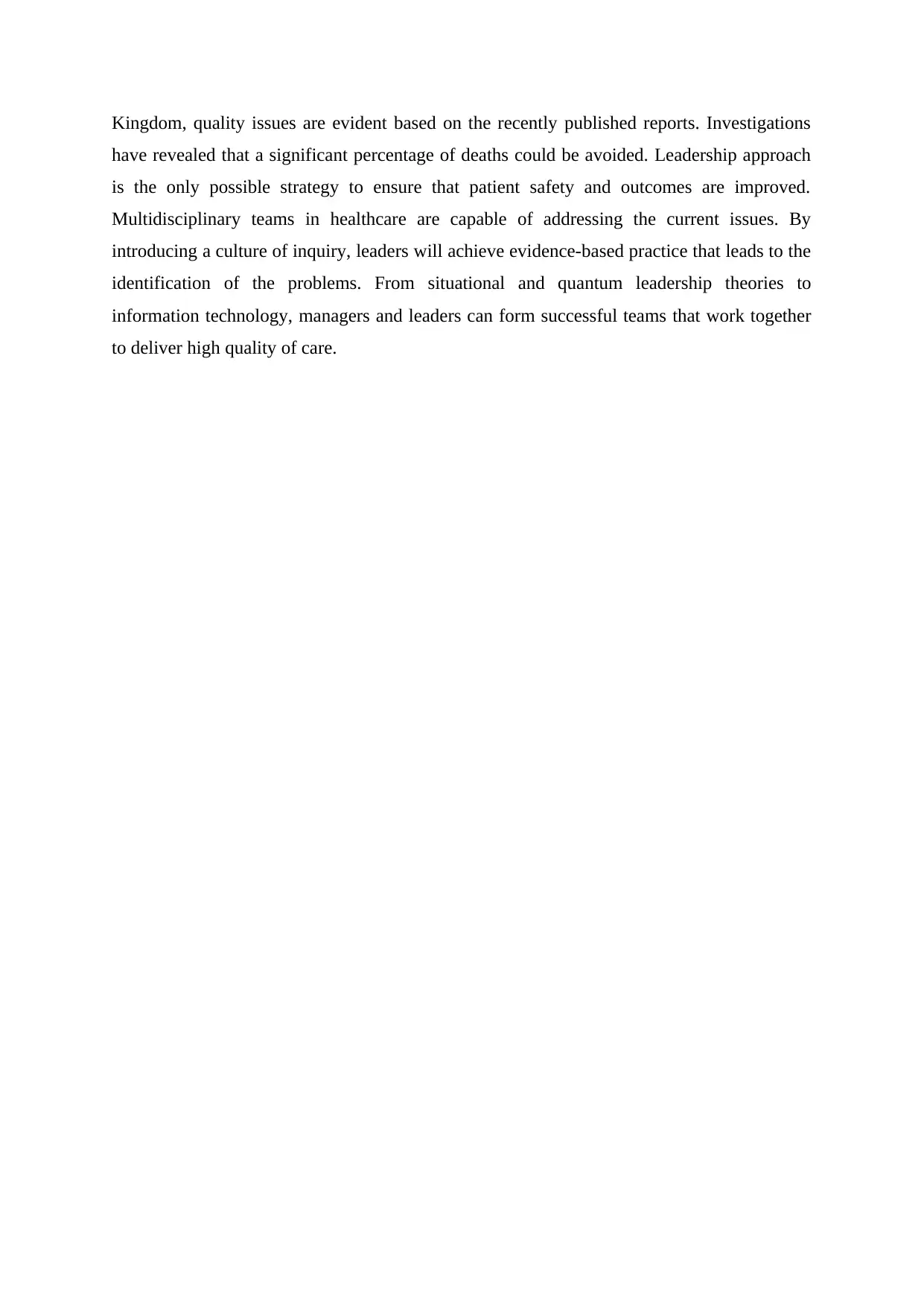
Kingdom, quality issues are evident based on the recently published reports. Investigations
have revealed that a significant percentage of deaths could be avoided. Leadership approach
is the only possible strategy to ensure that patient safety and outcomes are improved.
Multidisciplinary teams in healthcare are capable of addressing the current issues. By
introducing a culture of inquiry, leaders will achieve evidence-based practice that leads to the
identification of the problems. From situational and quantum leadership theories to
information technology, managers and leaders can form successful teams that work together
to deliver high quality of care.
have revealed that a significant percentage of deaths could be avoided. Leadership approach
is the only possible strategy to ensure that patient safety and outcomes are improved.
Multidisciplinary teams in healthcare are capable of addressing the current issues. By
introducing a culture of inquiry, leaders will achieve evidence-based practice that leads to the
identification of the problems. From situational and quantum leadership theories to
information technology, managers and leaders can form successful teams that work together
to deliver high quality of care.
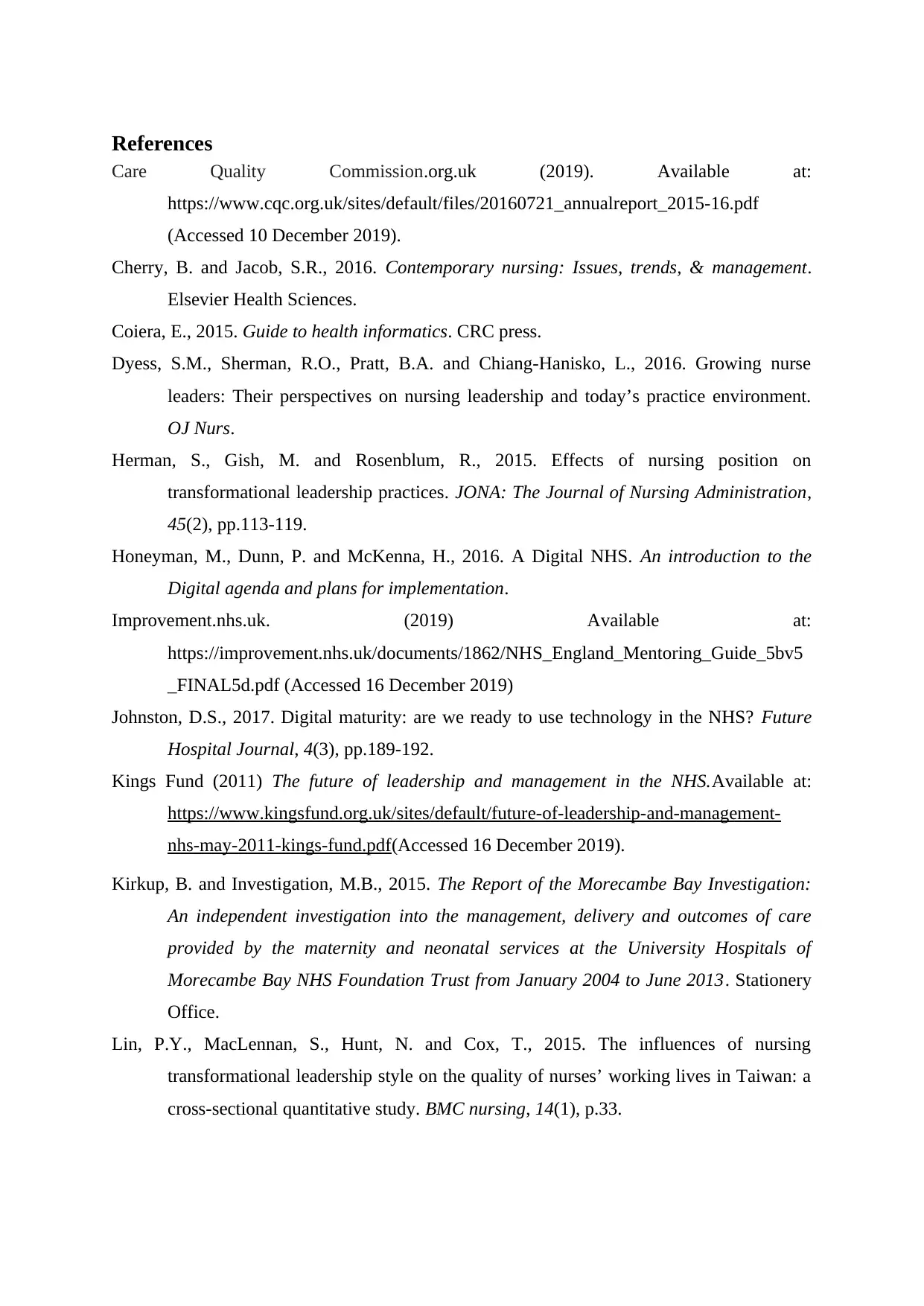
References
Care Quality Commission.org.uk (2019). Available at:
https://www.cqc.org.uk/sites/default/files/20160721_annualreport_2015-16.pdf
(Accessed 10 December 2019).
Cherry, B. and Jacob, S.R., 2016. Contemporary nursing: Issues, trends, & management.
Elsevier Health Sciences.
Coiera, E., 2015. Guide to health informatics. CRC press.
Dyess, S.M., Sherman, R.O., Pratt, B.A. and Chiang-Hanisko, L., 2016. Growing nurse
leaders: Their perspectives on nursing leadership and today’s practice environment.
OJ Nurs.
Herman, S., Gish, M. and Rosenblum, R., 2015. Effects of nursing position on
transformational leadership practices. JONA: The Journal of Nursing Administration,
45(2), pp.113-119.
Honeyman, M., Dunn, P. and McKenna, H., 2016. A Digital NHS. An introduction to the
Digital agenda and plans for implementation.
Improvement.nhs.uk. (2019) Available at:
https://improvement.nhs.uk/documents/1862/NHS_England_Mentoring_Guide_5bv5
_FINAL5d.pdf (Accessed 16 December 2019)
Johnston, D.S., 2017. Digital maturity: are we ready to use technology in the NHS? Future
Hospital Journal, 4(3), pp.189-192.
Kings Fund (2011) The future of leadership and management in the NHS.Available at:
https://www.kingsfund.org.uk/sites/default/future-of-leadership-and-management-
nhs-may-2011-kings-fund.pdf(Accessed 16 December 2019).
Kirkup, B. and Investigation, M.B., 2015. The Report of the Morecambe Bay Investigation:
An independent investigation into the management, delivery and outcomes of care
provided by the maternity and neonatal services at the University Hospitals of
Morecambe Bay NHS Foundation Trust from January 2004 to June 2013. Stationery
Office.
Lin, P.Y., MacLennan, S., Hunt, N. and Cox, T., 2015. The influences of nursing
transformational leadership style on the quality of nurses’ working lives in Taiwan: a
cross-sectional quantitative study. BMC nursing, 14(1), p.33.
Care Quality Commission.org.uk (2019). Available at:
https://www.cqc.org.uk/sites/default/files/20160721_annualreport_2015-16.pdf
(Accessed 10 December 2019).
Cherry, B. and Jacob, S.R., 2016. Contemporary nursing: Issues, trends, & management.
Elsevier Health Sciences.
Coiera, E., 2015. Guide to health informatics. CRC press.
Dyess, S.M., Sherman, R.O., Pratt, B.A. and Chiang-Hanisko, L., 2016. Growing nurse
leaders: Their perspectives on nursing leadership and today’s practice environment.
OJ Nurs.
Herman, S., Gish, M. and Rosenblum, R., 2015. Effects of nursing position on
transformational leadership practices. JONA: The Journal of Nursing Administration,
45(2), pp.113-119.
Honeyman, M., Dunn, P. and McKenna, H., 2016. A Digital NHS. An introduction to the
Digital agenda and plans for implementation.
Improvement.nhs.uk. (2019) Available at:
https://improvement.nhs.uk/documents/1862/NHS_England_Mentoring_Guide_5bv5
_FINAL5d.pdf (Accessed 16 December 2019)
Johnston, D.S., 2017. Digital maturity: are we ready to use technology in the NHS? Future
Hospital Journal, 4(3), pp.189-192.
Kings Fund (2011) The future of leadership and management in the NHS.Available at:
https://www.kingsfund.org.uk/sites/default/future-of-leadership-and-management-
nhs-may-2011-kings-fund.pdf(Accessed 16 December 2019).
Kirkup, B. and Investigation, M.B., 2015. The Report of the Morecambe Bay Investigation:
An independent investigation into the management, delivery and outcomes of care
provided by the maternity and neonatal services at the University Hospitals of
Morecambe Bay NHS Foundation Trust from January 2004 to June 2013. Stationery
Office.
Lin, P.Y., MacLennan, S., Hunt, N. and Cox, T., 2015. The influences of nursing
transformational leadership style on the quality of nurses’ working lives in Taiwan: a
cross-sectional quantitative study. BMC nursing, 14(1), p.33.
⊘ This is a preview!⊘
Do you want full access?
Subscribe today to unlock all pages.

Trusted by 1+ million students worldwide
1 out of 16
Related Documents
Your All-in-One AI-Powered Toolkit for Academic Success.
+13062052269
info@desklib.com
Available 24*7 on WhatsApp / Email
![[object Object]](/_next/static/media/star-bottom.7253800d.svg)
Unlock your academic potential
Copyright © 2020–2025 A2Z Services. All Rights Reserved. Developed and managed by ZUCOL.





